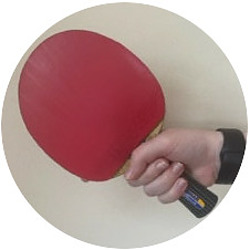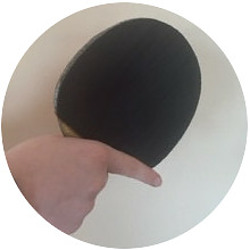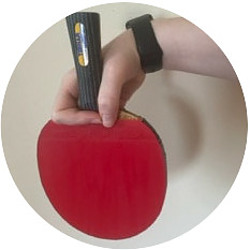
In table tennis, having a correct grip is crucial to achieve control, accuracy and power in your shots. No matter what level you are, being able to understand and master the correct way of how to hold a table tennis bat is fundamental to your performance. In this post we will go into the different types of grips and provide a step by step guide on how to use them.
Shakehand Grip
The shakehand grip is the most used grip in the sport and is suitable for players at any skill level. It is known for its versatility for various play styles. This grip allows for excellent control and balance, allowing players to execute a wide range of shots.
How to achieve the shakehand grip:
- Hold your hand out like you were going to shake someones hand. Insert the bat into the webbing between your thumb and finger.
- Make sure your index finger is extended out straight along the bottom of the rubber.
- Wrap your remaining fingers around the handle so you have full grip of the bat.
- Ensure your fingers are relaxed and comfortable. Do not grip too tight!
- Maintain a slight angle between your forearm and the handle. This is to make your wrist more flexible.


From my experience coaching, many players struggle with keeping their index finger on the bottom of the rubber. Many players have this extended higher up into the middle of the bat. This leads to either, it being in the way for your backhand or, you have to change grips between backhand and forehand, which is not ideal. I would recommend you placing a coin under your finger at the bottom of the rubber. Your aim is to hold this in place while you are playing. This should help you keep your finger there, and over time make it feel more natural.
Forehand & Backhand Grip
The shakehand grip can come with slight variations. These are the forehand and backhand grip. Personally, as a coach, I would not encourage these grips. If someone I coached used either of these grips, I would try to change it to a more neutral grip. However, I will take you through the main points about them if you believe they are more suited for you.
The most popular out of the two is the forehand grip due to it being a more popular shot. The forehand grip is achieved by rotating your bat slightly anti-clockwise. This lines the bat up more with your wrist and can make it much easier to play and generate more spin on your forehand. However, due to the angle of your wrist, playing a backhand becomes much more difficult. The chances are your technique will be incorrect when playing a backhand.
The backhand grip is less common but is still used. Often, what will happen is, if you have a forehand grip, as you go to play a backhand, you will change to a backhand grip so that it is possible to play the shot. This is not a great technique as it takes time to adjust your bat. Meaning you have less time to prepare for each shot and sometimes you may not be able to change grips in time. To achieve the backhand grip it is similar to the forehand but rotate clockwise. This will provide more support when playing a backhand. However, can make it very difficult to produce spin on the forehand.
Penhold Grip
The penhold grip is much less common. It is popular among players who prefer more wrist action in their shots. There is two different types of penhold. The Chinese penhold grip and the Japanese penhold grip. With both of these you get great wrist mobility however, playing shots from your crossover is much more difficult than playing with shakehand grip. You will also find it is much harder to use your backhand, especially with the Japanese grip.
How to achieve the Chinese penhold grip:
- Start with bat face up, hold the handle between your thumb and index finger, like you were holding a pen.
- Curl your other fingers around the back of the handle, ensuring you have a secure grip.
- Adjust the position of your thumb until you find it is comfortable.
- Maintain a relaxed grip to help with wrist mobility.


The Chinese penhold grip is the second most used in table tennis. It is easier to do with a Chinese penhold handle blade. This blade has a straight and shorter handle making it easier to hold in this grip. A downside of this grip is having a reduced area on the backhand.
How to achieve the Japanese penhold grip:
- Like with the Chinese penhold start with bat face up, hold the handle between your thumb and index finger.
- Extend your remaining fingers out along the back side of the bat.
- Adjust your fingers until you find it comfortable. Some like to have the fingers rest on top of each other, others prefer to spread them apart. Pick whichever feels more comfortable for you.


The Japanese penhold grip is much more rare. Due to the position of your fingers it relies on the sole use of the forehand. Once again, there is a specific blade for the Japanese penhold grip, these are light. A downside of this grip is there is no backhand at all, you have to rely on only using the forehand and inverting it when the ball comes to the backhand side.
Soft Hands
Regardless of what grip style you choose, it is important to get the correct grip pressure. You must avoid gripping the bat too tightly! It will restrict you flexibility, hamper your ability to generate spin and make it much more difficult to block your opponents spin. You may find you need to adjust your grip pressure depending on who you play against. If you play against someone who generates a lot of spin, you will need a very light grip. However, when playing against someone who doesn’t generate as much you don’t need it to be so light. A coaching tip I give to others is to have soft hands. This means to not grip the bat as hard and cushion the ball into the bat.
Conclusion
Being able to hold a table tennis bat correctly is essential in your development. I would strongly recommend to any new players to take up the shakehand grip. It is the most diverse to be able to cover all the shots and it is easier to master than either of the two penhold grips. Remember, whichever grip you choose, find a comfortable and secure grip which promotes flexibility and control. Regular practice ensuring you have the correct grip will help it to become more natural.
If you have any questions feel free to ask below or email me. I am always happy to help!
Ebony
ebony@pingpongpye.com



This article about table tennis bat grip styles is a valuable resource for players aiming to improve their game. It offers a well-structured breakdown of different grip techniques, aiding readers in understanding their unique advantages and drawbacks. By discussing the nuances of each grip style, the article assists players in selecting the grip that aligns best with their playing style and goals. Whether a beginner or an experienced player seeking to refine their technique, this article serves as an informative guide to optimizing table tennis performance through effective grip choices. Thanks for sharing
Thank you, I am glad you enjoyed the post
Hi Ebony,
Thanks for this article, really interesting.
I love an occasional game of ping pong, but I’ve never thought of how I hold the bat, nor how that may affect my game. Now I’ve read your article I can picture in my mind’s eye how I’ve watched professional players hold their bats and I can see the different techniques you have described being used.
You’ve provided a lot of information and the use of pictures showing each hold is excellent.
Thanks for taking the time to prepare this article.
Cherie :o)
I am glad you found this article interesting. The grip is one of the most influential aspects on your game. Having an improper grip could hinder some of your techniques and limit your progress. Going forward I hope you can implement your preferred grip style and use it effectively!
I am due to go on vacation soon and always end up playing a few games of table tennis. So your article has just exposed my typical grip, which is the standard handshake grip.
However I do struggle with keeping my index finger at the bottom of the rubber. It just naturally works its way to the middle of the bat. So I am going to try your tip of placing a coin under the finger and see if it helps.
As for the other grips, they look way too complicated.
Thanks for a great article
Rob
Hi Rob. I am glad you found this article useful. I hope using the coin under your index finger works for you, I have tried this technique with many beginners and it seems to work for them!
The penhold grips can be more complicated so, stick with the one that you feel most comfortable using.
Having played ping pong for a long time when I was studying, I found this topic very interesting and exciting. As you mention in this great article, the Shakehand Grip is the most common and frequent. I very rarely encountered someone with a different grip, and I never really tried them as I wasn’t comfortable with different grips.
Now that you talk about this topic, I’m curious to know whether there is any relationship between the types of grip and the corresponding types of rubber, or conversely, whether there is no relationship at all.
I appreciate your article, and for sharing your experience and advice.
Hi Pablo,
There isn’t really any patterns between the type of grip and the type of rubbers that are used. It is all individual. However, when using penhold grip one side of the bat is often not used – due to this players will occasionally buy a cheaper rubber or a pimple rubber for that side of their bat.
This has fallen away in recent years as penhold players have started using the back of their bat for a backhand.
I hope this answers your question!
Hi, Ebony! Thanks for this great article that really digs in to explain the different bat grip styles. As a beginner, I want to make sure that I’m developing good habits and that starts with learning about the hows and whys of different grip styles. I’m excited to give the shakehand a try (as you recommend for beginners) and see how things progress!
Hi there, I am glad you enjoyed this article. Developing good habits when starting out in table tennis can help you progress further. I hope you find success in trying the shakehand grip. If you have any questions we will be available to answer and give any guidance you may need.
This article’s a goldmine for table tennis fanatics, no doubt. I appreciate the emphasis on the importance of finding the right balance between grip pressure and flexibility. But I have some questions to ask, does your choice of table tennis bat and rubber actually influence which grip style suits you best? And speaking of grips, are there any secret exercises or drills we can use to improve them?
I’m all ears, and I’m betting other ping-pong enthusiasts would love to get the scoop on these details too. Let’s keep the discussion going!
Hi,
You can combine any grip with any rubbers. It all comes down to what suits you best. Try things out and see what works for you.
For exercises to improve grip that’s a tricky one. The main way is to do some standard exercises but focussing on maintaining the correct grip. I helps to have someone watching you to try identify when your grip slips away from the correct form. If you can’t do that then recording yourself and watching it back is the next best thing.
Grip is all about muscle memory – keep training it and it will become natural, ignore it and it will become a bad habit.
I hope this helps!